Ingrid Bergman
Ingrid Bergman[lower-alpha 1] (29 August 1915 – 29 August 1982) was a Swedish actress who starred in a variety of European and American films, television movies, and plays.[1] She won many accolades, as a thespian who achieved the Triple Crown of Acting with three Academy Awards, two Primetime Emmy Awards, and a Tony Award, along with four Golden Globe Awards, and a BAFTA Award.
Ingrid Bergman | |
|---|---|
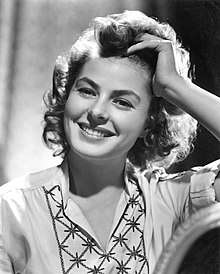 Bergman in 1944 | |
| Born | 29 August 1915 |
| Died | 29 August 1982 (aged 67) |
| Resting place | Norra begravningsplatsen, Solna, Stockholm, Sweden |
| Nationality | Swedish |
| Citizenship |
|
| Occupation | Actress |
| Years active | 1932–1982 |
Notable work | |
| Spouse(s) | |
| Children | 4, including Pia Lindström and Isabella Rossellini |
| Awards | List of awards and nominations |
| Website | ingridbergman.com |
| Signature | |
 | |
Bergman was born in Stockholm to a Swedish father and a German mother, and started her acting career in Swedish and German films. Her introduction to Americans came in the English-language remake of Intermezzo (1939). In addition to the classic and Best Picture Academy Award-winning Casablanca (1942) opposite Humphrey Bogart, her notable performances from the 1940s include the dramas For Whom the Bell Tolls (1943), Gaslight (1944), The Bells of St. Mary's (1945), and Joan of Arc (1948), all of which earned her nominations for the Academy Award for Best Actress; she won the award for Gaslight. She made three films with Alfred Hitchcock including Spellbound (1945), with Gregory Peck, and Notorious (1946), opposite Cary Grant.
In 1950, she starred in Roberto Rossellini's Stromboli, following the revelation that she was having an extramarital affair with the director. The affair and then marriage to Rossellini created a scandal in the United States that forced her to remain in Europe for several years, during which she starred in Rossellini's Journey to Italy (1954), now critically acclaimed. She made a successful return to working for a Hollywood studio in Anastasia (1956), the debut film for Yul Brynner, winning her second Academy Award for Best Actress. In 1958, she starred for a second time with Cary Grant, this time in the popular romantic comedy Indiscreet.
In her later years, she won her third Academy Award, this one for Best Supporting Actress, for her small performance in Murder on the Orient Express (1974). In 1978, she worked with director Ingmar Bergman (no relation) in Autumn Sonata, for which she received her sixth Academy Award nomination for Best Actress. In her final acting role, she portrayed the late-Israeli Prime Minister Golda Meir in the television mini-series A Woman Called Golda (1982) for which she posthumously won her second Emmy Award for Best Actress. She died on her sixty-seventh birthday (29 August 1982) from breast cancer.
According to the St. James Encyclopedia of Popular Culture, Bergman quickly became "the ideal of American womanhood" and a contender for Hollywood's greatest leading actress.[2] In the United States, she is considered to have brought a "Nordic freshness and vitality" to the screen, along with exceptional beauty and intelligence; David O. Selznick once called her "the most completely conscientious actress" he had ever worked with. In 1999, the American Film Institute ranked Bergman as the fourth-greatest female screen legend of Classic Hollywood Cinema.[3]
Early years
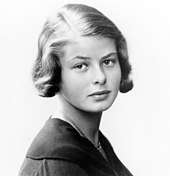
Ingrid Bergman was born on 29 August 1915 in Stockholm, to a Swedish father, Justus Samuel Bergman (2 May 1871 – 29 July 1929),[5] and his German wife, Frieda Henriette Auguste Louise (née Adler) Bergman (12 September 1884 – 19 January 1918), who was born in Kiel.[6][7] Her parents married in Hamburg on 13 June 1907.[8][9] She was named after Princess Ingrid of Sweden. She mainly grew up in Sweden, but spent the summers in Germany, and spoke fluent German.[10]
Ingrid suffered a succession of crucial losses in her infancy and childhood, which she may have experienced as abandonments. When she was two or three years old, her mother died. When Ingrid was 13, she lost her father, who had been an artist and photographer. He had wanted Ingrid to become an opera star and, during his lifetime, had her take voice lessons for three years. Her father had documented all her birthdays with a borrowed camera.[11] After her father's death, Ingrid was sent to live with his sister, Ellen Bergman, who also died of heart disease only six months later.
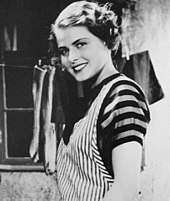
Ingrid then lived with her maternal aunt Hulda and her husband Otto, who had five children of their own. She also visited with her other maternal aunt, Elsa Adler, whom the young girl called Mutti (Mom) according to family lore.[6]:294She later said she "knew from the beginning that [she] wanted to be an actress," sometimes wearing her dead mother's clothes and staging plays in her father's empty studio.
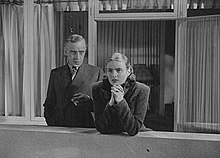
Later, Bergman received a scholarship to the state-sponsored Royal Dramatic Theatre School, where Greta Garbo had some years earlier earned a similar scholarship. After several months, she was given a part in a new play, Ett Brott (A Crime), written by Sigfrid Siwertz. Chandler notes that this was "totally against procedure" at the school, where girls were expected to complete three years of study before getting such acting roles.[6]:33 During her first summer break, Bergman was hired by a Swedish film studio, which led to her leaving the Royal Dramatic Theatre after just one year, to work in films full-time. Her first film role after leaving the Royal Dramatic Theatre was a small part in Munkbrogreven (1935), although she reportedly had previously been an extra in the 1932 film Landskamp).
She went on to act in a dozen films in Sweden, including Intermezzo (1936) which is graced by a leading performance by Ingrid Bergman (her first), in a role created especially for her, and En kvinnas ansikte, which was later remade as A Woman's Face with Joan Crawford, and one film in Germany, Die vier Gesellen (The Four Companions) (1938).
Hollywood period: 1939–1949
Intermezzo: A Love Story (1939)
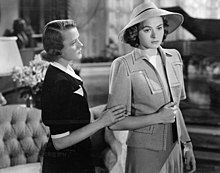
Bergman's first acting role in the United States came when Hollywood producer David O. Selznick brought her to America to star in Intermezzo: A Love Story (1939), an English language remake of her earlier Swedish film Intermezzo (1936). Unable to speak English, and uncertain about her acceptance by the American audience, she expected to complete this one film and return home to Sweden. Her husband, Dr. Petter Aron Lindström, remained in Sweden with their daughter Pia (born 1938).[6]:63 In Intermezzo, she played the role of a young piano accompanist opposite Leslie Howard as a famous violin virtuoso. She arrived in Los Angeles on 6 May 1939, and stayed at the Selznick home until she could find another residence. According to Selznick's son Danny, who was a child at the time, his father had concerns about Ingrid: "She didn't speak English, she was too tall, her name sounded too German, and her eyebrows were too thick."
Bergman was soon accepted without having to modify her looks or name, despite some early suggestions by Selznick.[6]:6 "He let her have her way", notes a story in Life magazine. Selznick understood her fear of Hollywood make-up artists, who might turn her into someone she wouldn't recognize, and "instructed them to lay off". He was also aware that her natural good looks would compete successfully with Hollywood's "synthetic razzle-dazzle".[11] During the following weeks, while Intermezzo was being filmed, Selznick was also filming Gone with the Wind. In a letter to William Hebert, his publicity director, Selznick described a few of his early impressions of Bergman:
Miss Bergman is the most completely conscientious actress with whom I have ever worked, in that she thinks of absolutely nothing but her work before and during the time she is doing a picture ... She practically never leaves the studio, and even suggested that her dressing room be equipped so that she could live here during the picture. She never for a minute suggests quitting at six o'clock or anything of the kind ... Because of having four stars acting in Gone with the Wind, our star dressing-room suites were all occupied and we had to assign her a smaller suite. She went into ecstasies over it and said she had never had such a suite in her life ... All of this is completely unaffected and completely unique and I should think would make a grand angle of approach to her publicity ... so that her natural sweetness and consideration and conscientiousness become something of a legend ... and is completely in keeping with the fresh and pure personality and appearance which caused me to sign her.[12]:135–136
Intermezzo became an enormous success and as a result Bergman became a star. The film's director, Gregory Ratoff, said "She is sensational", as an actress. This was the "sentiment of the entire set", writes Life, adding that workmen go out of their way to do things for her, and the cast and crew "admired the quick, alert concentration she gave to direction and to her lines".[11] Film historian David Thomson notes that this became "the start of an astonishing impact on Hollywood and America", where her lack of make-up contributed to an "air of nobility". According to Life, the impression that she left on Hollywood, after she returned to Sweden, was of a tall (5 ft. 9 in.) girl "with light brown hair and blue eyes who was painfully shy, but friendly, with a warm, straight, quick smile".[11] Selznick appreciated her uniqueness, and with his wife Irene, they remained important friends throughout her career.[13]:76
Dr Jekyll and Mr Hyde (1941)
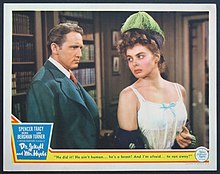
After Rage in Heaven and Adam Had Four Sons, Bergman was tired of playing saintly, good girl roles. For her next film, Dr Jekyll and Mr Hyde co- starring Spencer Tracy and Lana Turner, Bergman was slated to play Tracy's character fiancee but pleaded with director Victor Fleming that she played "bad girl" Ivy instead of Turner. Critics and audience praised Bergman's performance as excellent and breathtaking.
During filming, Tracy said to be infatuated with the 26-year-old Bergman. Despite of them both being married at the time, they did have a short affair. Tracy even threatened to leave the film if MGM picked Turner to play his love interest.[14]
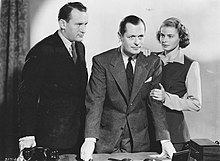
Casablanca (1942)
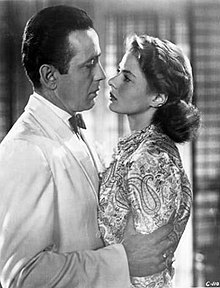
After the onset of World War II, Bergman "felt guilty because she had so misjudged the situation in Germany" while she was there filming Die vier Gesellen (The Four Companions). According to one of her biographers, Charlotte Chandler (2007), she had at first considered the Nazis only a "temporary aberration, 'too foolish to be taken seriously'. She believed Germany would not start a war." Bergman felt that "the good people there would not permit it". Chandler adds, "Ingrid felt guilty all the rest of her life because when she was in Germany at the end of the war, she had been afraid to go with the others to witness the atrocities of the Nazi extermination camps".[6]:293–295 In 1945, she and her first husband, Dr. Petter Aron Lindström, who wed on 10 July 1937 in Stöde,[8] became United States citizens.[8][8]
After completing a final film in Sweden and appearing in three moderately successful films (Adam Had Four Sons, Rage in Heaven, and Dr. Jekyll and Mr. Hyde, all 1941) in the United States, Bergman co-starred with Humphrey Bogart in the classic film Casablanca (1942), which remains her best-known role. Her line "Play it, Sam. Play As Time Goes By", has been voted at no 28 in the list of AFI's 100 Movie Quotes.[15] In this film, she played the role of Ilsa, the beautiful Norwegian wife of Victor Laszlo, played by Paul Henreid, an "anti-Nazi underground hero" who is in Casablanca, a haven from the Nazis.[6]
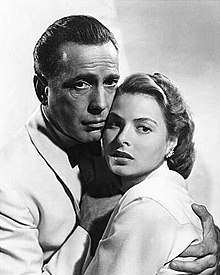
Bergman did not consider Casablanca to be one of her favorite performances. "I made so many films which were more important, but the only one people ever want to talk about is that one with Bogart."[16] In later years, she stated, "I feel about Casablanca that it has a life of its own. There is something mystical about it. It seems to have filled a need, a need that was there before the film, a need that the film filled".[6]:88
Biographer Charlotte Chandler said that Bergman wanted out of the film because the film had no finished script and having scenes rewritten as the filming progress. Bergman also had difficulty of connecting with Bogart whose wife accusing them of having an affair despite of Bogart chose to mostly remain in his trailer off scene. In his romantic scenes with his costar, Bogart said that he did not do anything he hasn't done before but when someone looks like Ingrid Bergman and she tells you that she loves you, that would make anybody feel romantic.[17]
For Whom the Bell Tolls (1943)

After Casablanca, with "Selznick's steady boosting", she played the part of Maria in For Whom the Bell Tolls (1943), which was also her first color film. For the role, she received her first Academy Award nomination for Best Actress. The film was taken from Ernest Hemingway's novel of the same title and co-starred Gary Cooper. When the book was sold to Paramount Pictures, Hemingway stated that, "Miss Bergman, and no one else, should play the part". His opinion came from seeing her in her first American role, Intermezzo, although he hadn't yet met her. A few weeks later, they did meet, and after studying her, he said, "You are Maria!".[11]
Gaslight (1944)
.jpg)
The following year, she won the Academy Award for Best Actress for Gaslight (1944), a film in which George Cukor directed her as a "wife driven close to madness" by her husband, played by Charles Boyer. Going into filming, Bergman was worried that she was unable to portray a timid and fragile character. She viewed herself as an independent and strong woman and her taking the role as a great challenge as an actress. Bergman even went to a mental hospital in order to study about nervous breakdowns. David O. Selznick wanted Ingrid Bergman as top billing instead of Boyer. Bergman pleaded to Selznick that she was very keen on the role and wanted so much to work with Boyer she did not even care not to get top billing. Selznick relented.[18]
Filming their first love scene made Bergman really uncomfortable. She had just met Boyer. Bergman was known to have like rehearsals to get to know her costars better. The film, according to Thomson, "was the peak of her Hollywood glory".[13]:77
Bergman next played a nun in The Bells of St. Mary's (1945), opposite Bing Crosby, for which she received her third consecutive nomination for Best Actress. In the film she played Sister Benedict who always at odds with Crosby's Father O'Malley on how to run a school. This was a sequel to Going My Way (1944) and was the top grossing movie of 1945.
Saratoga Trunk (1945)
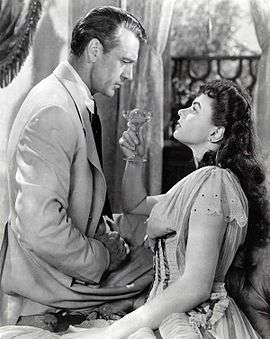
Bergman also starred in Saratoga Trunk (1945), reuniting with Gary Cooper though the film was originally shot in 1943 but not released until 1945.[19]
Spellbound (1945), Notorious (1946), Under Capricorn (1949)
Bergman starred in the Alfred Hitchcock films Spellbound (1945), Notorious (1946), and Under Capricorn (1949). She was a student of the acting coach Michael Chekhov during the 1940s. Chekhov acted with Bergman in Spellbound and received his only Academy Award nomination for his performance.[20]
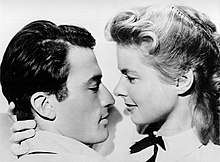
Spellbound, Bergman first of three collaborations with Alred Hitchcock was a story about psychoanalysis which famous for a dream sequence by Salvador Dalí. Bergman played Dr Constance Petersen, a cold, bookish and detached psychiatrist whose analysis could determine whether or not Dr Anthony Edwardes, played by Gregory Peck is guilty of murder or not. Along the way, they fell in love. The film was a box office smashing hit when it released in 1945 which had been a very successful year for Ingrid Bergman.
Then, came Notorious, the second and perhaps the most successful out of three films with Hitchcock. Bergman played a US spy, a daughter of convicted traitor during World War 2 who had been given an assignment to infiltrate the Nazi symphatizers in South America. Along the way, she fell in love with her fellow spy, played by Cary Grant. The pairing of Bergman and Grant was sure to be a huge success because they were both at top of their game.
.jpg)
The making of the film proved to be one of the most satisfying experience for Hitchcock and his two megastars. Bergman was known for her perfectionism. Despite that, she was able to enchant both Hitchcock and Grant during the production. Hitchcock was even ready to accept Bergman's input and suggestions regarding her role of Alicia. It also helped that Grant and Bergman had a remarkable and sizzling chemistry. Dubbed as two most iconic of Hitchcock stars who brought their most attractive and mysterious qualities to the film.[21]
Joan of Arc (1948)
Bergman received another Best Actress nomination for Joan of Arc (1948), an independent film based on the Maxwell Anderson play Joan of Lorraine, produced by Walter Wanger, and initially released through RKO. Bergman had championed the role since her arrival in Hollywood, which was one of the reasons she had played it on the Broadway stage in Anderson's play. The film was not a big hit with the public, partly because of the scandal of Bergman's affair with Italian film director Roberto Rossellini, which broke while the film was still in theatres. Even worse, it received disastrous reviews, and, although nominated for several Academy Awards, did not receive a Best Picture nomination. It was subsequently cut by 45 minutes, but restored to full length in 1998, and released in 2004 on DVD.
Between motion pictures, Bergman had appeared in the stage plays Liliom, Anna Christie, and Joan of Lorraine. During a press conference in Washington, D.C. for the promotion of Joan of Lorraine, she protested against racial segregation after seeing it first hand at the theater she was acting in. This led to a lot of publicity and some hate mail. Bergman went to Alaska during World War II to entertain US Army troops. Soon after the war ended, she also went to Europe for the same purpose, where she was able to see the devastation caused by the war.
Italian period with Rossellini: 1949–1957
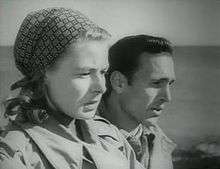
Bergman strongly admired two films by Italian director Roberto Rossellini that she had seen in the United States. In 1949, Bergman wrote to Rossellini, expressing this admiration and suggesting that she make a film with him. This led to her being cast in his film Stromboli (1950). During production, Bergman fell in love with Rossellini, they began an affair, and Bergman became pregnant with their son, Renato Roberto Ranaldo Giusto Giuseppe ("Robin") Rossellini (born 2 February 1950).[22]:18
This affair caused a huge scandal in the United States, where it led to Bergman being denounced on the floor of the United States Senate. Ed Sullivan chose not to have her on his show, despite a poll indicating that the public wanted her to appear.[23] However, Steve Allen, whose show was equally popular, did have her as a guest, later explaining "the danger of trying to judge artistic activity through the prism of one's personal life".[23] Spoto notes that Bergman had, by virtue of her roles and screen persona, placed herself "above all that". She had played a nun in The Bells of St. Mary's (1945), and a virgin saint in Joan of Arc (1948). Bergman later said, "People saw me in Joan of Arc, and declared me a saint. I'm not. I'm just a woman, another human being."[24]
As a result of the scandal, Bergman returned to Italy, leaving her husband and daughter Pia. She went through a publicized divorce and custody battle for their daughter. Bergman and Rossellini were married on 24 May 1950.[25] In addition to Renato, they had twin daughters (born 18 June 1952): Isabella Rossellini, who became an actress and model, and Isotta Ingrid Rossellini, who became a professor of Italian literature.
Stromboli and "neorealism"
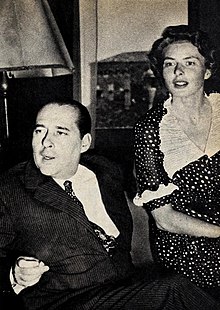
Rossellini completed five films starring Bergman between 1949 and 1955: Stromboli, Europa '51, Viaggio in Italia, Giovanna d'Arco al rogo, and La Paura (Fear).
Rossellini directed her in a brief segment of his 1953 documentary film, Siamo donne (We, the Women), which was devoted to film actresses.[22]:18 His biographer, Peter Bondanella, notes that problems with communication during their marriage may have inspired his films' central themes of "solitude, grace, and spirituality in a world without moral values".[22]:19
Rossellini's use of a Hollywood star in his typically "neorealist" films, in which he normally used non-professional actors, did provoke some negative reactions in certain circles. In Bergman's first film with Rossellini, her character was "defying audience expectations" in that the director preferred to work without a script, forcing Bergman to act "inspired by reality while she worked, a style which Bondanella calls 'a new cinema of psychological introspection'".[22]:98 Bergman was aware of Rossellini's directing style before filming, as the director had earlier written to her explaining that he worked from "a few basic ideas, developing them little by little" as a film progressed.[22]:19
After separating from Rossellini, Bergman starred in Jean Renoir's Elena and Her Men (Elena et les Hommes, 1956), a romantic comedy in which she played a Polish princess caught up in political intrigue.
Later years: 1957–1982
Anastasia (1956)
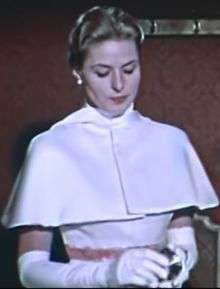
With her starring role in 1956's Anastasia (1956), Bergman made a triumphant return to working for a Hollywood studio (albeit in a film produced in Europe) and won the Academy Award for Best Actress for a second time. Its director, Anatole Litvak, described her as "one of the greatest actresses in the world". He also offered his description of her at the time:
Ingrid looks better now than she ever did. She's 42, but she looks divine. She is a simple, straightforward human being. Through all her troubles she held to the conviction that she had been true to herself and it made her quite a person. She is happy in her new marriage, her three children by Rossellini are beautiful, and she adores them.[26]
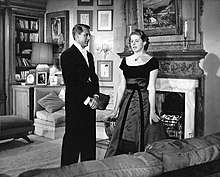
She starred in the 1958 picture The Inn Of Sixth Happiness, based on a true story about a Christian missionary woman to China. Bergman made her first post-scandal public appearance in Hollywood at the 30th Academy Awards in 1959 when she was the presenter of the Academy Award for Best Picture.[27] She was given a standing ovation after being introduced by Cary Grant as she walked onto the stage to present the award. She continued to alternate between performances in American and European films for the rest of her career and made occasional appearances in television dramas such as The Turn of the Screw (1959) for the Ford Startime TV series—for which she won the Emmy Award for Outstanding Single Performance by an Actress.
During this time, she performed in several stage plays. She married producer Lars Schmidt, a fellow Swede, on 21 December 1958. This marriage ended in divorce in 1975. After a long hiatus, Bergman made the film Cactus Flower (1969), with Walter Matthau and Goldie Hawn. In this movie, she played a dental nurse-receptionist who is secretly in love with her boss, the dentist, played by Matthau. The New York Times wrote "The teaming of Matthau, whose dour, craggy virility now supplants the easy charm of Barry Nelson, and the ultra-feminine Miss Bergman, in a rare comedy venture, was inspirational on somebody's part. The lady is delightful as a (now) 'Swedish iceberg', no longer young, who flowers radiantly while running interference for the boss's romantic bumbling. The two stars mesh perfectly."[28] After the success of Cactus Flower, Bergman moved on to another film that paired her once again with Anthony Quinn, A Walk in the Spring Rain. It was critically panned.
In addition to her film work, Bergman also acted on the stage. In 1940 she made her Broadway debut in Liliom. She later appeared in such critically acclaimed plays as Hedda Gabler (Paris, 1962), A Month in the Country (Great Britain, 1965), and Captain Brassbound’s Conversion (London, 1971). She won a Tony Award for her performance in Joan of Lorraine (1946–47), and her last Broadway appearance was in The Constant Wife (1975). She also starred in the television plays The Turn of the Screw (1959) and Hedda Gabler (1963).
In 1972, U.S. Senator Charles H. Percy entered an apology into the Congressional Record for the verbal attack made on Bergman 22 years earlier by Edwin C. Johnson.
Bergman was the president of the jury at the 1973 Cannes Film Festival.[29]
Cactus Flower (1969)
In 1969, Bergman was eager to work in American screen again after many years hiatus. Producer Mike Frankovic later contacted her to offer her a role of a spinster, prim, nurse assistant to Walter Matthau in Cactus Flower, based on a successful Broadway play. The film also will be costarring a newcomer, Goldie Hawn as Matthau's doe-eyed, giddy girlfriend. The studio offered her $800,000 or about $5.3 million in today's value. Bergman hesitated to take the role after the long absence. When the film came out, it got rave reviews and Hawn later won an Oscar for her supporting role.[30]
Both Walter Matthau and newcomer Goldie Hawn were in awe of Bergman. They were worried whether they all can get along during the set. But Bergman's warmth and graciousness won them over. Later, Goldie Hawn said;
"I thought I'd be awfully intimidated by her, so intimidated I wouldn't be able to function. It wasn't that way at all. I didn't feel I had to compete. I just felt privileged to be in the same picture with her. She has a regal quality. It's too bad she isn't the queen of some country or something."
Murder on the Orient Express (1974)
Bergman became one of the few actresses ever to receive three Oscars when she won her third (and first in the category of Best Supporting Actress) for her performance in Murder on the Orient Express (1974). Director Sidney Lumet offered Bergman the important part of Princess Dragomiroff, with which he felt she could win an Oscar. She insisted on playing the much smaller role of Greta Ohlsson, the old Swedish missionary. Lumet discussed Bergman's role:
She had chosen a very small part, and I couldn't persuade her to change her mind. She was sweetly stubborn. But stubborn she was ... Since her part was so small, I decided to film her one big scene, where she talks for almost five minutes, straight, all in one long take. A lot of actresses would have hesitated over that. She loved the idea, and made the most of it. She ran the gamut of emotions. I've never seen anything like it.[6]:246–247
Bergman could speak Swedish (her native language), German (her second language, learned from her German mother and in school), English (learned when brought over to the United States), Italian (learned while living in Italy),[31] and French (her third language, learned in school). She acted in each of these languages at various times. Fellow actor Sir John Gielgud, who had acted with her in Murder on the Orient Express, and who had directed her in the play The Constant Wife, playfully commented: "She speaks five languages, and can't act in any of them."[32] (This is from a Dorothy Parker quote which became a snowclone, "That woman speaks eighteen languages, and can't say 'No' in any of them.")
Although known chiefly as a film star, Bergman strongly admired the great English stage actors and their craft. She had the opportunity to appear in London's West End, working with such stage stars as Sir Michael Redgrave in A Month in the Country (1965), Gielgud in The Constant Wife (1973) and Dame Wendy Hiller in Waters of the Moon (1977–1978).[33]
Autumn Sonata (1978)
In 1978, Bergman played in Autumn Sonata (Höstsonaten), by Ingmar Bergman (no relation), for which she received her 7th—and final—Academy Award nomination. This was her final performance on the big screen. In the film, Bergman plays a celebrity pianist who travels to Norway to visit her neglected daughter, played by Liv Ullmann. The film was shot in Norway. In 1979, Bergman hosted the AFI's Life Achievement Award Ceremony for Alfred Hitchcock.
A Woman Called Golda (1982)
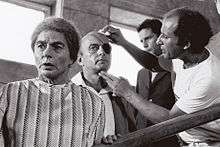
She was offered the starring role in a television mini-series, A Woman Called Golda (1982), about the late Israeli prime minister Golda Meir. It was to be her final acting role and she was honored posthumously with a second Emmy Award for Best Actress. Her daughter Isabella described Bergman's surprise at being offered the part and the producer trying to explain to her, "People believe you and trust you, and this is what I want, because Golda Meir had the trust of the people." Isabella adds, "Now, that was interesting to Mother." She was also persuaded that Golda was a "grand-scale person", one that people would assume was much taller than she actually was. Chandler notes that the role "also had a special significance for her, as during World War II, Ingrid felt guilty because she had so misjudged the situation in Germany".[6]:293
According to Chandler, "Ingrid's rapidly deteriorating health was a more serious problem. Insurance for Bergman was impossible. Not only did she have cancer, but it was spreading, and if anyone had known how bad it was, no one would have gone on with the project." After viewing the series on TV, Isabella commented,
She never showed herself like that in life. In life, Mum showed courage. She was always a little vulnerable, courageous, but vulnerable. Mother had a sort of presence, like Golda, I was surprised to see it ... When I saw her performance, I saw a mother that I'd never seen before—this woman with balls.[6]:290
Bergman was frequently ill during the filming although she rarely complained or showed it. Four months after the filming was completed, she died, on her 67th birthday. After her death, her daughter Pia accepted her Emmy.[6]:296
Personal life
In 1937, at the age of 21, Bergman married a dentist, Petter Aron Lindström (1 March 1907 – 24 May 2000), who later became a neurosurgeon. The couple had one child, a daughter, Friedel Pia Lindström (born 20 September 1938). After returning to the United States in 1940, she acted on Broadway before continuing to do films in Hollywood. The following year, her husband arrived from Sweden with Pia. Lindström stayed in Rochester, New York, where he studied medicine and surgery at the University of Rochester. Bergman traveled to New York and stayed at their small rented stucco house between films, her visits lasting from a few days to four months. According to an article in Life magazine, the "doctor regards himself as the undisputed head of the family, an idea that Ingrid accepts cheerfully". He insisted she draw the line between her film and personal life, as he has a "professional dislike for being associated with the tinseled glamor of Hollywood". Lindström later moved to San Francisco, California, where he completed his internship at a private hospital, and they continued to spend time together when she could travel between filming.[11]
On 27 August 1945, two days before her 30th birthday, as Ingrid Lindstrom, she and her husband both filed "Declaration of Intention" forms with the United States District Court, Southern District of California.[34]
According to Victor Fleming's biographer, Michael Sragow, Bergman and the director had an affair during the filming of Joan of Arc. Fleming was a married man. Fleming's daughter said that if her father was leaving his wife for another woman, it would have been for Ingrid Bergman. Fleming died of heart attack shortly after the filming ended.[35]
Bergman had a brief affair with war photographer Robert Capa after she met him as she entertained the Allied troops in 1945. She even invited him to come visit her on the set of Hitchcock's Notorious. After the shooting ended, they broke up. Their affair had been the basis of Hitchcock making Rear Window years later.[36]
During her marriage with Lindström, Bergman had a brief affair with Spellbound co-star Gregory Peck.[37] Unlike her later affair with Rossellini, the affair with Peck was kept private until he confessed it to Brad Darrach of People in an interview five years after Bergman's death. Peck said, "All I can say is that I had a real love for her (Bergman), and I think that's where I ought to stop ... I was young. She was young. We were involved for weeks in close and intense work."[38][39][40]
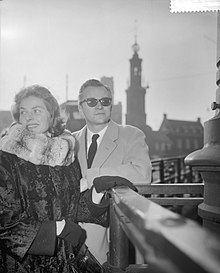
Bergman returned to Europe after the scandalous publicity surrounding her affair with Italian director Roberto Rossellini during the filming of Stromboli in 1950. In the same month the film was released, she gave birth to a boy, Renato Roberto Ranaldo Giusto Giuseppe ("Robin") Rossellini (born 2 February 1950). A week after her son was born, she divorced Lindström and married Rossellini in Mexico. On 18 June 1952, she gave birth to the twin daughters Isotta Ingrid Rossellini and Isabella Rossellini. In 1957, Rossellini had an affair with Sonali Das Gupta and soon after, Bergman and Rossellini separated. Rossellini later married Sonali Das Gupta in 1957.[41][42]
In 1958, Bergman married Lars Schmidt, a theatrical entrepreneur from a wealthy Swedish shipping family. Curiously, while vacationing with Lars in Monte Gordo beach (Algarve region, Portugal) in 1963, right after recording the TV movie Hedda Gabler, Ingrid got ticketed for wearing a bikini that showed too much according to the modesty standards of conservative Portugal.[43] After almost two decades of marriage, Ingrid and Lars divorced in 1975. He was, however, by her side when she died.[44]
Bergman was a Lutheran,[45] once saying of herself, "I'm tall, Swedish, and Lutheran".[46]
Death and legacy
Bergman died on 29 August 1982 at 12:00 am, her 67th birthday, in London, of breast cancer. Her body was cremated at Kensal Green Cemetery, London, and her ashes taken to Sweden. Most of them were scattered in the sea around the islet of Dannholmen off the fishing village of Fjällbacka in Bohuslän, on the west coast of Sweden, where she spent most of the summers from 1958 until her death in 1982. The rest were placed next to her parents' ashes in Norra Begravningsplatsen (Northern Cemetery), Stockholm, Sweden.
Her friends and costars expressed their feelings, stricken by the news of her death. Cary Grant, who led a private life after his retirement, chose not to give any comments. Joseph Cotten who himself was ailing at the time said that she has earned herself a place in the history of cinema. Bergman's husband in Casablanca, Paul Henreid said that he was deeply distressed by the news. Bergman, whom he said was terribly beautiful in her youth has led a colourful life and considered her a great actress and a dear friend. Liv Ullman, Leonard Nimoy and Yossi Graber who all had worked with her in some of her later films also revealed their deep sadness, alluding to her courage in fighting the cancer that eventually cost her life.[47]
According to biographer Donald Spoto, she was "arguably the most international star in the history of entertainment". After her American film debut in the film Intermezzo: A Love Story (1939), co-starring Leslie Howard, Hollywood saw her as a unique actress who was completely natural in style and without need of make-up. Film critic James Agee wrote that she "not only bears a startling resemblance to an imaginable human being; she really knows how to act, in a blend of poetic grace with quiet realism".[2]
According to film historian David Thomson, she "always strove to be a 'true' woman", and many filmgoers identified with her:
There was a time in the early and mid-1940s when Bergman commanded a kind of love in America that has been hardly ever matched. In turn, it was the strength of that affection that animated the "scandal" when she behaved like an impetuous and ambitious actress instead of a saint.[13]:76
Writing about her first years in Hollywood, Life magazine stated that "All Bergman vehicles are blessed", and "they all go speedily and happily, with no temperament from the leading lady".[11] She was "completely pleased" with her early career's management by David O. Selznick, who always found excellent dramatic roles for her to play, and equally satisfied with her salary, once saying, "I am an actress, and I am interested in acting, not in making money." Life adds that "she has greater versatility than any actress on the American screen ... Her roles have demanded an adaptability and sensitiveness of characterization to which few actresses could rise".[11]
She continued her acting career while suffering from cancer for eight years, and won international honors for her final roles. "Her spirit triumphed with remarkable grace and courage", adds Spoto.[24] Director George Cukor once summed up her contributions to the film media when he said to her, "Do you know what I especially love about you, Ingrid, my dear? I can sum it up as your naturalness. The camera loves your beauty, your acting, and your individuality. A star must have individuality. It makes you a great star. A great star."[6]:11
In 1960, Bergman was inducted into the Hollywood Walk of Fame with a motion pictures star located at 6759 Hollywood Boulevard.[48]
Woody Guthrie, who had a huge crush on Bergman, wrote a song about her in 1950s.[49]
In 1990, film critic Roger Ebert named Ingrid Bergman as his favorite actress.[50] Bergman's Casablanca and Notorious were among Ebert's 10 favorite movies of all time.
In 1996, Entertainment Weekly named her 12th on their list of 100 Greatest Movie Stars of All Time.
In March 2015, a picture of Bergman photographed by David Seymour was chosen for the main poster for the 2015 Cannes Film Festival. A documentary titled Ingrid Bergman: In Her Own Words was also screened at the festival.[51]
In August 2015, US Postal issued the Ingrid Bergman Commemorative Forever stamp to celebrate the cinema icon's centennial.[52]
In 2016, critics from gay community compiled their pick of all time female acting greats that includes Ingrid Bergman, Cate Blanchett, Katharine Hepburn, and Meryl Streep.[53]
Autobiography
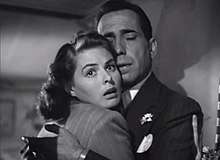
In 1980, Bergman's autobiography, Ingrid Bergman: My Story, was written with the help of Alan Burgess. In it, she discusses her childhood, her early career, her life during her time in Hollywood, the Rossellini scandal, and subsequent events. The book was written after her children warned her that she would only be known through rumors and interviews if she did not tell her own story. It was through this autobiography that her affair with Robert Capa became known.
Filmography
Awards and Nominations
Bergman was only the second actress to win three Academy Awards for acting: two for Best Actress, and one for Best Supporting Actress. She is tied for second place of Oscars won, with Walter Brennan, Jack Nicholson, Meryl Streep, and Daniel Day-Lewis (all three for Best Actor). Bergman won the inaugural Tony Award for Best Actress in a Play for her portrayal of Joan of Arc in Joan of Lorraine.
References
Woody Guthrie composed "Ingrid Bergman", a song about Bergman in 1950. The lyrics have been described as "erotic" and makes reference to Bergman's relationship with Roberto Rossellini, which began during work on the film Stromboli. This song was never recorded by Guthrie but it was set to music and recorded by Billy Bragg on the album Mermaid Avenue after being discovered in the Woody Guthrie Archive with thousands of other songs.[54]
Notes
- Swedish: [ˈɪ̌ŋːrɪd ˈbæ̌rjman] (

References
- Obituary Variety, 1 September 1982.
- Pendergast, Tom; Pendergast, Sara (2000). St. James Encyclopedia of Popular Culture. Farmington Hills, Michigan: Gale Publishing. ISBN 1-55862-405-8.
- "AFI's 100 Years ... 100 Stars". American Film Institute. Archived from the original on 20 October 2006. Retrieved 23 October 2006.
- "Ingrid Bergman: a life in pictures". The Guardian. 15 July 2015. Retrieved 29 December 2017.
- "The Official Ingrid Bergman Web Site". Ingridbergman.com. Retrieved 31 May 2017.
- Chandler, Charlotte (2007). Ingrid: Ingrid Bergman, A Personal Biography. New York: Simon & Schuster. pp. 19, 21, 294. ISBN 978-0-7432-9421-8.
- Ziolkowska-Boehm, Aleksandra (28 August 2013). Ingrid Bergman and her American Relatives. ISBN 9780761861515.
- "Ancestry Library Edition". ancestrylibrary.proquest.com.
- Standesamt Hamburg 3, 1907 No. 173
- Arne Lunde, Nordic Exposures: Scandinavian Identities in Classical Hollywood Cinema, p. 157, University of Washington Press, 2011, ISBN 9780295800844
- Carlile, Thomas, and Speiser, Jean. Life Magazine, 26 July 1943, pp. 98–104
- Selznick, David O. Memo from David O. Selznick, Selected and edited by Rudy Behlmer, Viking Press (1972), in letter dated 22 June 1939
- Thomson, David. The New Biographical Dictionary of Film, Alfred A. Knopf, N.Y. (2002)
- Chilton, Martin (6 April 2020). "The monster of MGM: was Spencer Tracy the most toxic man in Hollywood?". The Telegraph. ISSN 0307-1235. Retrieved 25 June 2020.
- "AFI's 100 YEARS…100 MOVIE QUOTES". American Film Institute. Retrieved 24 June 2020.
- "Ingrid Bergman - The Official Licensing Website of Ingrid Bergman". Ingrid Bergman. Retrieved 22 February 2019.
- Callahan, Dan (22 February 2018). The Art of American Screen Acting, 1912-1960. McFarland. ISBN 978-1-4766-7405-6.
- Anthony, Scott (3 June 2019). "A FILM TO REMEMBER: "GASLIGHT" (1944)". Medium. Retrieved 26 June 2020.
- Bogle, Donald (2011), Heat Wave: The Life and Career of Ethel Waters, Harper-Collins, p. 369, ISBN 978-0-06-124173-4
- Adam J. Ledger. "Michael Chekhov". Literary Encyclopedia. The Literary Dictionary Company Limited. Retrieved 6 March 2007.
- Coffin, Lesley L. (11 September 2014). Hitchcock's Stars: Alfred Hitchcock and the Hollywood Studio System (in Arabic). Rowman & Littlefield. ISBN 978-1-4422-3078-1.
- Bondanella, Peter E. The Films of Robert Rossellini, Cambridge University Press (1993)
- "Steve Allen: The Mike Wallace Interview". Harry Ransom Center, University of Texas at Austin. 7 July 1957. Retrieved 5 November 2015.
- Spoto, Donald. Notorious: The Life of Ingrid Bergman, HarperCollins (1997), p. 300
- Smit, David (12 October 2012). Ingrid Bergman: The Life, Career and Public Image. McFarland. ISBN 9781476600598.
- "Is Ingrid the Greatest?", The Indianapolis Star, 16 July 1961.
- Gary Moody. "All the Oscars: 1958". OscarSite.com – A celebration of all things Oscar. Retrieved 10 December 2006.
- Howard Thompson. "'Cactus Flower' Blooms". New York Times - Review of Cactus Flower. Retrieved 23 January 2019.
- "Ingrid Bergman profile". Cannes Film Festival. Archived from the original on 12 March 2006. Retrieved 23 October 2006.
- Carter, Grace May (24 November 2016). Ingrid Bergman. New Word City. ISBN 978-1-61230-098-6.
- Leamer, Laurence (1986). As Time Goes By: The Life of Ingrid Bergman. Harper & Row. ISBN 0-06-015485-3.
- "The Punch Line". Las Vegas Review-Journal. 26 August 2002. Retrieved 22 October 2006.
- Quirk, Lawrence (1989). The Complete Films of Ingrid Bergman. New York: Citadel Press. pp. 213, 221, 223.
- "Ancestry Library Edition". Ancestrylibrary.proquest.com. Retrieved 22 February 2019.
- Sragow, Michael (19 November 2013). Victor Fleming: An American Movie Master. University Press of Kentucky. ISBN 978-0-8131-4443-6.
- "Robert Capa at 100: The war photographer's legacy". www.bbc.com. Retrieved 12 July 2020.
- Haney, Lynn (2009). Gregory Peck: A Charmed Life. De Capo Press. ISBN 9780786737819.
- Fishgall, Gary (2002). Gregory Peck: A Biography. Simon and Schuster. p. 98. ISBN 9780684852904.
ingrid bergman gregory peck affair.
Page 98 - Smit, David (2012). Ingrid Bergman: The Life, Career and Public Image. ISBN 9780786472260.Page 30
- Darrach, Brad (15 June 1987). "Gregory Peck". People. Retrieved 5 October 2015.
- "The Girl Who Turned Rossellini's Head - Times of India". The Times of India. Retrieved 10 December 2017.
- "The scandal that rocked Calcutta". www.telegraphindia.com.
- "O bikini". Repórter à Solta.
- Smit, David (2012). Ingrid Bergman: The Life, Career and Public Image. McFarland. p. 116.
- Carter, Grace May (24 November 2016). Ingrid Bergman. New Word City. ISBN 9781612300986 – via Google Books.
- "A Profile in Courage, Ingrid Bergman Plays Golda While Battling Cancer". people.com. Retrieved 22 February 2019.
- "Actress remembered as strong in cancer fight". UPI. Retrieved 23 June 2020.
- "Hollywood Walk of Fame - Ingrid Bergman". walkoffame.com. Hollywood Chamber of Commerce. Retrieved 16 November 2017.
- Songfacts. "Ingrid Bergman by Billy Bragg - Songfacts". www.songfacts.com. Retrieved 23 June 2020.
- "Playboy Interview: Gene Siskel and Roger Ebert". Atavist. 17 August 2016. Retrieved 20 June 2020.
- "It's poster time at the Festival de Cannes!". Cannes. Retrieved 24 March 2015.
- "Ingrid Bergman honored with Forever stamp". about.usps.com. Retrieved 24 June 2020.
- "Top Actresses of All Time as Voted by Gay Critics Group". www.hollywoodreporter.com. Retrieved 23 June 2020.
- Canoni, Anna. "Anna Canoni about Woody Guthrie". Song facts (Interview). Carl Wiser.
Sources
- Bergman, Ingrid; Burgess, Alan (1980). Ingrid Bergman: My Story. New York: Delacorte Press. ISBN 0-440-03299-7.
- Chandler, Charlotte (2007). Ingrid: Ingrid Bergman, A Personal Biography. New York: Simon & Schuster. ISBN 978-0-7432-9421-8.
- Leamer, Laurence (1986). As Time Goes By: The Life of Ingrid Bergman. New York: Harper & Row. ISBN 0-06-015485-3.
- Dagrada, Elena (2008). Le Varianti Trasparenti. I Film con Ingrid Bergman di Roberto Rossellini. Milano: LED Edizioni Universitarie. ISBN 978-88-7916-410-8.
- Ziolkowska-Boehm, Aleksandra (2013). Ingrid Bergman prywatnie. Warsaw: Proszynski. ISBN 978-83-7839-518-8.
- Ziolkowska-Boehm, Aleksandra (2013). Ingrid Bergman and her American Relatives. Lanham, MD: Hamilton Books. ISBN 978-0-7618-6150-8.
External links
![]()
![]()
- Ingrid Bergman on IMDb

- Ingrid Bergman at AllMovie

- Ingrid Bergman at the TCM Movie Database

- Ingrid Bergman at the Internet Broadway Database

- Ingrid Bergman at the Encyclopædia Britannica
- Ingrid Bergman site run by CMG
- Ingrid Bergman Collection at Wesleyan University
- Ingrid Bergman site run by Schirmer/Mosel Publishers Munich
- 1943 New York Times Interview
- Trailer from Isabella Rossellini's Ingrid Bergman A Life in Pictures
- Photos of Ingrid Bergman in Spellbound by Ned Scott
- Remembering Ingrid Bergman at 100, August, 2015